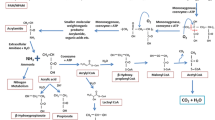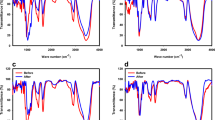Abstract
Polyaspartate synthesized using thermal methods (thermal polyaspartate; TPA) has been shown to have dispersant and crystallization inhibition activities. These activities suggest that the polymer may be used in water treatment and paper processing and as a detergent and paint additive. The commercial potential for TPA is enhanced by the fact that it may be synthesized on a large scale. Therefore, a study of the biodegradation of the polymer was undertaken. TPA was produced by hydrolysis of a polysuccinimide synthesized by dry thermal polymerization of aspartic acid. The resulting polymer was a poly(α,β-dl-aspartate) having a 70% β structure and containing a racemic mixture of aspartic acid. TPA was incubated with both dilute effluent and activated sludge from a wastewater treatment plant. Low-biomass effluent experiments showed changes in molecular size of TPA concomitant with oxygen demand induced by the polymer, suggesting susceptibility of TPA to at least partial biodegradation. Low-biomass sludge experiments (SCAS, modified Sturm) yielded approximately 70% mineralization of 20 mg L−1 TPA by 28 days, suggesting that a significant portion of the polymer was labile. High-biomass sludge experiments using14C-TPA at 1 mg L−1 revealed approximately 30% mineralization and 95% total removal of TPA carbon from solution in 23 days, with most of the mineralization and removal taking place in less than 5 days. Additional short-term studies using a variety of particulate substrates, including activated sludge, confirmed that TPA is subject to removal from solution by adsorption. From these studies with labeled TPA, it was concluded that TPA is subject to rapid removal and at least partial degradation in a wastewaster treatment plant. Using gel and thin-layer chromatography, it was determined that at least part of the unmineralized residue from the high biomass assays was polyaspartate. It is speculated that the unusual structure of TPA compared to natural proteins may limit the rate of proteolysis of the polymer and thus its overall degradation rate.
Similar content being viewed by others
References
G. Chiaudani and P. Poltronien (1990)Ingegneria Ambientale 11.
T. Hayashi, M. Mukouyama, K. Sakano, and Y. Tani (1993)Appl. Environ. Microbiol. 59(5), 1555–1559.
S. Matsumura and S. Yoshikawa (1990) in J. E. Glass and G. Swift (Eds.),Agricultural and Synthetic Polymers, Biodegradability and Utilization, ACS symposium Series 433, Am. Chem. Soc., Washington, DC, pp. 124–135.
S. Matsumura, K. Amaya, and S. Yoshikawa (1993)J. Environ. Polym. Degrad. 1 23–29.
G. Swift and B. Weinstein (1993) U.S. Patent No. 5, 191,048.
C. S. Sikes and A. P. Wheeler (1985) U.S. Patent No. 4,534,881.
A. P. Wheeler and C. S. Sikes (1986) U.S. Patent No. 4,587,021.
C. S. Sikes and A. P. Wheeler (1988)CHEMTECH 18 620–626.
A. P. Wheeler and C. S. Sikes (1989) in S. Mann, J. Webb, and R. J. P. Williams (Eds.),Biomineralization: Chemical and Biochemical Perspectives, VCH, Weinheim, Germany, pp. 95–131.
A. P. Wheeler, K. C. Low, and C. S. Sikes (1991) in C. S. Sikes and A. P. Wheeler (Eds.),Surface Reactive Peptides and Polymers: Discovery and Commercialization, ACS Symposium Series 444, Am. Chem. Soc., Washington, DC, pp. 72–84.
C. S. Sikes, M. L. Yeung, and A. P. Wheeler (1991) in C. S. Sikes and A. P. Wheeler (Eds.),Surface Reactive Peptides and Polymers: Discovery and Commercialization, ACS Symposium Series 444, Am. Chem. Soc., Washington, DC, pp. 50–71.
C. S. Sikes, E. M. Mueller, J. D. Madura, B. Drake, and B. J. Little (1993)Corrosion 93, No. 465.
S. W. Fox and K. Harada (1966) in P. Alexander and H. P. Lundgren (Eds.),A Laboratory Manual of Analytical Methods of Protein Chemistry, Pergamon Press, Oxford, pp. 127–151.
L. P. Koskan (1991) U.S. Patent No. 5,057,597.
A. P. Wheeler and L. P. Koskan (1993)Mat. Res. Soc. Symp. 292 277–283.
J. Kovacs, H. N. Kovacs, I. Könyres, J. Csaszár, T. Vajda, and H. Mix (1961)J. Org. Chem. 26 1084–1091.
E. Kokufuta, S. Shinnichiro, and K. Harada (1978)Bull. Chem. Soc. Japan 51 1555–1556.
H. Pivcová, V. Saudek, J. Drobník, and J. Vlasík (1981)Biopolymers 20 1605–1614.
L. P. Koskan, K. C. Low, A. R. Meah, and A. M. Atencio (1992) U.S. Patent No. 5,152,902.
L. P. Koskan and K. C. Low (1992) U.S. Patent No. 5,116,513.
H. Pivcová, V. Saudek, and H. Drobník (1982)Polymer 23 1237–1241.
V. Saudek, S. Strokrová, and P. Schmidt (1982)Biopolymers 21 1011–1020.
A. Vegotsky, K. Harada, and S. W. Fox (1958)J. Am. Chem. Soc. 80 3361–3366.
OECD (1981)OECD Guidelines for Testing of Chemicals, Organization for Economic Cooperation and Development.
Standard Methods for the Examination of Water and Wastewater (1989) American Public Health Association, American Water Work Association, Water Pollution Control Federation, Port City Press, Baltimore, MD.
A. Vogel (1978)Textbook of Practical Organic Chemistry, 4th ed., Longman, London.
B. A. Boczar, W. M. Begley, and R. J. Larson (1992)Water Environ. Res. 64 792–797.
C. S. Cekolin (1991) M.S. thesis, University of South Alabama, Mobile.
W. G. Miller (1961)J. Am. Chem. Soc. 83 259–265.
W. G. Miller (1964)J. Am. Chem. Soc. 86 3913–3918.
W. G. Miller (1964)J. Am. Chem. Soc. 86 3918–3922.
P. Neri, G. Antoni, F. Benvenuti, F. Cocola, and G. Gazzei (1973)J. Med. Chem. 16 893–897.
M. B. Freeman, Y. H. Paik, G. Swift, S. K. Wolk, and K. M. Yocom (1994) presented at Polyamino Acids, The Emergence of Life, and Industrial Applications, ACS Symposium, San Diego, CA.
Metcalf and Eddy, Inc. (1979)Wastewater Engineering: Treatment, Disposal, Resuse, McGraw-Hill, New York.
Author information
Authors and Affiliations
Rights and permissions
About this article
Cite this article
Alford, D.D., Wheeler, A.P. & Pettigrew, C.A. Biodegradation of thermally synthesized polyaspartate. J Environ Polym Degr 2, 225–236 (1994). https://doi.org/10.1007/BF02071970
Issue Date:
DOI: https://doi.org/10.1007/BF02071970




